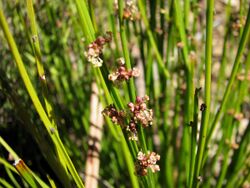Biology:Amperea xiphoclada
| Amperea xiphoclada | |
|---|---|

| |
| Scientific classification | |
| Kingdom: | Plantae |
| Clade: | Tracheophytes |
| Clade: | Angiosperms |
| Clade: | Eudicots |
| Clade: | Rosids |
| Order: | Malpighiales |
| Family: | Euphorbiaceae |
| Genus: | Amperea |
| Species: | A. xiphoclada
|
| Binomial name | |
| Amperea xiphoclada (Sieber ex Spreng.) Druce[1]
| |
| Synonyms | |
|
Leptomeria brownii Miq. Leptomeria xiphoclada Sieber ex Spreng. | |
Ampera xiphloclada, commonly known as ‘broom spurge’,[2] is a grass-like erect shrub[3] in the Euphorbiaceae family.[4]
Description
The smooth relatively thin branched, erect shrub is often lime green with dull, light brown sessile clustered flowers.[5]
Distribution
Ampera xipholoclada is found throughout Australia ’s eastern and southern coastal areas and inland ranges,[6] as well as much of Tasmania. Distribution and populations are relatively stable.
Habitat
This species is found in woodland, forest, and shrub (also known as heath areas in Australia) habitats. Ampera sp. prefers, a dry place, or by moist well-drained soils.[7]
Taxonomy
Leaves and stems
What appear to be long leaves like a monocot grass clump, the erect structures are instead glabrous stems, smooth and mainly hairless. This plant is almost leafless. During its flowering life stage, it is completely leafless, likely to put more energy into reproduction.
Flowers
Flowering occurs sectionally along the glabrous stem[6] typically from September to February,[8] dependent on the season. Flowers occur in sessile clusters (inflorescence) or with pedicels (part of the stalk that helps the cluster[9]). As this species is mainly dioecious the male and female flowers remain separate and are found on different individuals, rather than one plant having hermaphrodite flowers.
Reproduction and fruit
The fruit is small with three sections in the 2-4mm capsule, which contains the 1.5-2.5mm long, shiny black ovoid seeds.[10]
Uses and planting
Plants in the Euphorbiaceae family have diverse uses, but must be treated with caution as a large proportion of species are toxic, either in the seeds or in the flesh of stems.[4] However, some genus's' can be used as a source of rubber, fruit, dyes and have traditionally been used for medicinal purposes.
Ampera xiphloclada can be used for ground coverage and as an understory plant, and when given access to sunlight it can create a hedge-like feature.
References
- ↑ "Amperea xiphoclada". Australian Plant Name Index (APNI), IBIS database. Centre for Plant Biodiversity Research, Australian Government, Canberra. http://www.anbg.gov.au/cgi-bin/apni?TAXON_NAME=Amperea+xiphoclada. Retrieved 2009-12-12.
- ↑ "Fact sheet for Amperea xiphoclada". http://www.flora.sa.gov.au/cgi-bin/speciesfacts_display.cgi?form=speciesfacts&name=Amperea_xiphoclada.
- ↑ "PlantNET - FloraOnline". https://plantnet.rbgsyd.nsw.gov.au/cgi-bin/NSWfl.pl?page=nswfl&lvl=sp&name=Amperea~xiphoclada.
- ↑ 4.0 4.1 Webster, Grady L. (1986-04-01). "Irritant plants in the spurge family (Euphorbiaceae)" (in en). Clinics in Dermatology 4 (2): 36–45. doi:10.1016/0738-081X(86)90062-3. ISSN 0738-081X. https://dx.doi.org/10.1016/0738-081X%2886%2990062-3.
- ↑ "Amperea xiphoclada". https://apps.lucidcentral.org/plants_se_nsw/text/entities/amperea_xiphoclada.htm.
- ↑ 6.0 6.1 "ampera xiphloclada | Search | Atlas of Living Australia". https://bie.ala.org.au/search?q=ampera+xiphloclada.
- ↑ "Key to Tasmanian Dicots". https://www.utas.edu.au/dicotkey/dicotkey/EUPHORBS/gAmperea.htm.
- ↑ "Yarra Ranges Local Plant Directory" (in en-AU). https://www.yarraranges.vic.gov.au/PlantDirectory/Shrubs/Shrubs-to-2m/Amperea-xiphoclada.
- ↑ "Definition of PEDICEL" (in en). https://www.merriam-webster.com/dictionary/pedicel.
- ↑ "Flora of Victoria". https://vicflora.rbg.vic.gov.au/flora/taxon/c5c852b2-5fdd-4da3-b4d4-433e2408bd57.
Wikidata ☰ Q4748125 entry
 |

